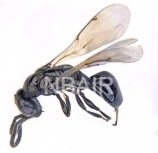Scientific name
Spalangia cameroni Perkins, 1910
Taxonomic position
Hymenoptera: Chalcidoidea: Pteromalidae
Diagnosis
Body length 2 mm. Body black, legs dark black except basal 3 tarsal segments yellow. Head smooth and shiny except for distinct setiferous punctures; gena without malar sulcus. Pronotal collar convex, anteriorly smoothly rounded to neck with distinct crenulate cross-line posteriorly. Mesoscutum median lobe with anterior convex region smooth and shiny; internotaular region irregularly punctate-rugose except smooth laterally or posterolaterally. Scutellum smooth and shiny except few setiferous punctures; frenum with complete crenulate punctures. Fore wing hyaline; bare behind submarginal vein. Propodeum reticulate rugose laterally and posteriorly; plical region with widened, usually more or less Y-shaped paramedian crenulate furrows delineating median carina. Petiole with longitudinal carinae. Metasoma smooth and shiny.
Image
 Adult - lateral view Adult - lateral view
Distribution
India: Delhi, Pondicherry, and Karnataka.
Biology / Hosts
Primary parasitoid of Diptera and as a hyperparasitoid of Bombyx mori (L.) (Lepidoptera: Bombycidae).
References
- Gibson, G.A.P. 2004. A new species of Oozetetes De Santis (Hymenoptera: Chalcidoidea: Eupelmidae) attacking oothecae of Nyctibora acaciana Roth (Orthoptera: Blattellidae). Journal of Hymenoptera Research, 13, 13-23.
- Gibson, G.A.P. 2009. Revision of New World Spalangiinae (Hymenoptera: Pteromalidae). Zootaxa 2259: 35-140 (2009).
- Noyes, J.S. 2012. Universal Chalcidoidea Database. World Wide Web electronic publication. http://www.nhm.ac.uk/chalcidoids.
|